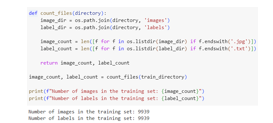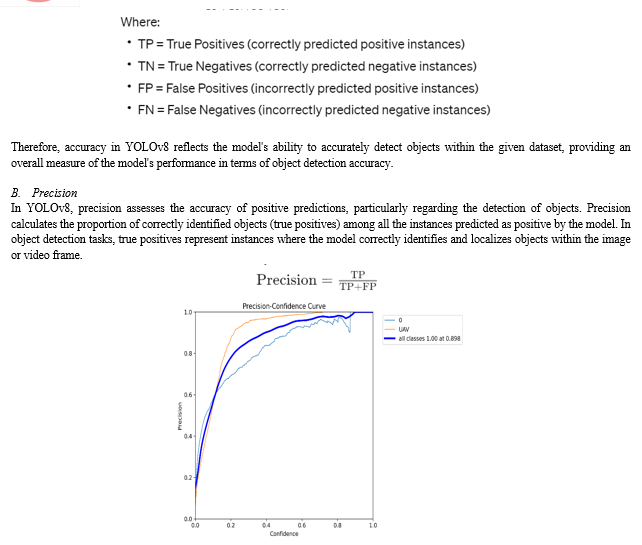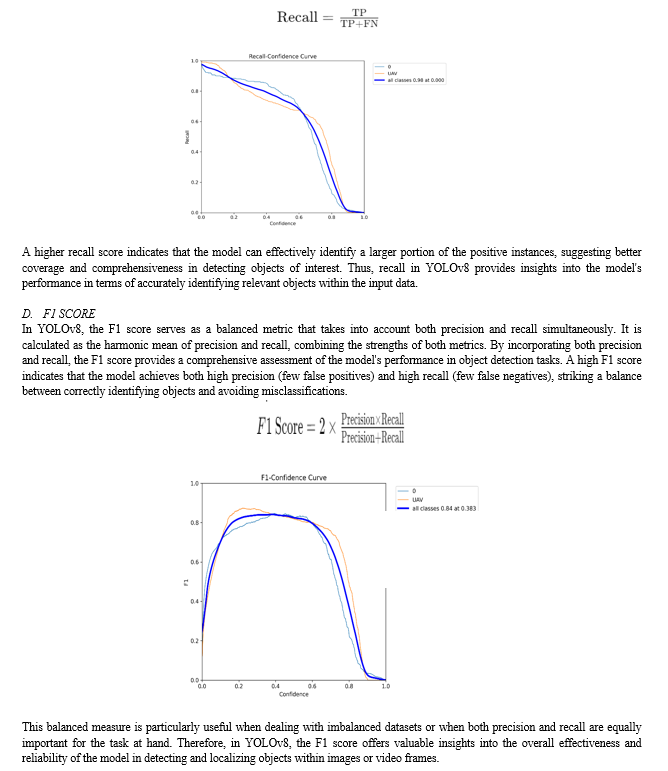Ijraset Journal For Research in Applied Science and Engineering Technology
- Home / Ijraset
- On This Page
- Abstract
- Introduction
- Conclusion
- References
- Copyright
Unauthorized Drone Detection Using Deep Learning
Authors: Bhavani P, Prasanna P, Dhivagar M, Velliangiry S
DOI Link: https://doi.org/10.22214/ijraset.2024.61496
Certificate: View Certificate
Abstract
The growing concerns over drone misuse in national airspace, including activities like drug smuggling and privacy violations, demand advanced drone detection systems. Traditional methods struggle to accurately identify drones among various airborne objects. YOLO v8, renowned for its efficient single-pass object detection, presents a sophisticated solution. Through training on annotated datasets featuring drones in diverse environments and fine-tuning with aerial imagery, YOLO v8 excels at recognizing drones amidst complex backgrounds. Its multi-scale detection capabilities enable it to detect drones of varying sizes, crucial for different distances from the camera. Real-time prediction ensures timely detection, vital for immediate responses to unauthorized intrusions. Integration with drone tracking systems enhances situational awareness, facilitating proactive measures. Furthermore, employing adaptive thresholding and post-processing techniques like Kalman filtering refines drone detection accuracy, reducing false positives. YOLO v8 thus emerges as a potent tool in mitigating risks associated with drone misuse, bolstering defenses against unauthorized activities in national airspace.
Introduction
I. INTRODUCTION
Drones, known as unmanned aerial vehicles (UAVs), have gained popularity across various sectors for their diverse applications, from military reconnaissance to commercial photography and security surveillance. However, their widespread use also poses security risks, including espionage and privacy breaches. Detecting drones presents a complex challenge due to their small size and agility. Traditional radar systems often struggle to differentiate drones from other objects. To address this, advanced technologies like radio frequency (RF) sensors, acoustic detection, and computer vision algorithms are being employed. Integration of these technologies enhances accuracy, with artificial intelligence, particularly deep learning, enabling adaptation to evolving drone technologies. Thus, a multifaceted approach combining various detection methods offers a comprehensive solution to mitigate security threats posed by drones in both military and commercial contexts.
Integrated drone detection systems, employing RF sensing, acoustic detection, and computer vision enhanced by AI, are vital for accurate identification across diverse scenarios. Privacy concerns mandate anonymization of data to respect individual rights. Regulatory frameworks, including operator registration and no-fly zones, are crucial for managing drone-related risks. Collaboration between stakeholders is essential for effective regulation and technology development. Continuous research and development efforts are needed to stay ahead of evolving threats, ensuring the dynamic evolution of counter-drone technologies. In summary, while drones offer benefits, robust detection mechanisms, balanced security-privacy approaches, and effective regulations are imperative to manage associated risks effectively.
II. RELATED WORK
- Real-Time Detection and Tracking of Multiple Drones with Deep Neural Networks" by Y. Hu, M. Lu, and Y. Li [1]
The research paper introduces a novel real-time drone detection and tracking system utilizing deep neural networks. Integrating YOLOv3 for detection and DeepSORT for tracking, the system is trained on a diverse dataset including authentic and synthetic drone data. Testing on drone videos showcases high accuracy in detection and tracking. Unique to this system is the combination of YOLOv3 and DeepSORT, leading to superior speed and accuracy compared to existing methods. The authors emphasize its versatility, suggesting applications in drone surveillance and monitoring. By addressing detection and tracking challenges in real-time, the system enhances security and situational awareness in areas requiring vigilant drone monitoring.
2. Drone Detection and Tracking Using Convolutional Neural Networks and Optical Flow by M. Hahn and K. Leppkes [2]
The paper presents a real-time drone detection and tracking system using a combination of CNNs and optical flow, optimized for single-camera setups.
The deep learning model is trained on a diverse dataset of drone images and videos, including synthetic and real-world data. A novel tracking algorithm incorporating Kalman filtering and the Hungarian algorithm enhances precision. Evaluation on real-world drone videos demonstrates high accuracy in detection and tracking. The synergy between CNNs and optical flow, along with the innovative tracking algorithm, ensures effectiveness in real-time scenarios. This research sets the stage for robust drone monitoring systems with single-camera setups, applicable in security, surveillance, and situational awareness contexts where timely and accurate drone detection and tracking are crucial.
3. Detection and Classification of UAVs Using Deep Learning and Feature Extraction Techniques by A. Khawar and S. Shahid [3]
The paper presents a drone detection and classification system integrating deep learning with feature extraction techniques, particularly employing Convolutional Neural Networks (CNNs) for classification and Principal Component Analysis (PCA) for data reduction. Through CNNs, the model learns intricate patterns from drone images, enabling accurate classification. PCA enhances system efficiency by reducing input data complexity. Testing on a dataset of drone images shows high accuracy in both detection and classification, demonstrating the system's effectiveness in discerning and categorizing drones based on visual features. The system's versatility suggests potential applications in drone surveillance and security. Its accurate detection and classification capabilities address concerns regarding unauthorized drone activities, offering valuable support for security measures in various environments. Overall, the paper provides a robust solution merging deep learning and feature extraction for drone detection and classification.
4. Automated drone detection and tracking system using deep learning" by S. Farhan, M. Waqar, and F. Ahmed [4]
The research introduces an automated drone detection and tracking system, combining YOLOv3 for detection and deep association network (DAN) for tracking. Trained on real-world data, the system exhibits high accuracy in both tasks, showcasing its effectiveness in practical scenarios. The integrated approach offers potential applications in border security and surveillance, providing timely and accurate detection and tracking of drones. Empowered by deep learning algorithms, the system contributes to enhancing security measures where drone detection and tracking are crucial, emphasizing real-world applicability and accuracy.
5. Detection and tracking of low-altitude UAVs using deep learning- based techniques" by T. Kim, Y. Kim, and J. Kim in Aerospace Science and Technology [5]
The research paper introduces a novel system for detecting and tracking low-altitude Unmanned Aerial Vehicles (UAVs) using deep learning techniques. It combines Convolutional Neural Networks (CNNs) for spatial feature extraction and Recurrent Neural Networks (RNNs) for capturing temporal dependencies in video frames, enabling dynamic analysis of UAV movements. A unique aspect is the introduction of an algorithm to predict UAV flight paths, enhancing proactive tracking. Evaluation on real-world UAV videos demonstrates high accuracy in detection and tracking tasks. The emphasis on real-world data enhances the system's practical applicability, suggesting its potential in critical scenarios requiring precise UAV monitoring. Overall, the paper contributes to UAV surveillance technologies by leveraging deep learning and predictive algorithms for enhanced detection and tracking capabilities.
III. IMPLEMENTATION
A. Data Collection
The data utilized in this research is sourced from the Kaggle open-source platform, specifically from a dataset titled "YOLOv8 - YOLO Drone Detection Dataset" created by a user named marquis03. This dataset likely contains images and videos relevant to drone detection, curated specifically for training and testing purposes. Given the name "YOLOv8," it suggests a focus on utilizing the YOLO (You Only Look Once) algorithm, a popular choice for object detection tasks, including drone detection. Such datasets typically include annotated images or videos where drones are labeled or marked, allowing algorithms to learn and identify drones accurately. By leveraging open-source datasets like this from platforms such as Kaggle, researchers and developers can access valuable resources to train and evaluate their drone detection models, contributing to advancements in the field of aerial surveillance and security.
https://www.kaggle.com/code/marquis03/yolov8-yolo-drone-detection-dataset/data
Pre-processing and splitting the data set:
Pre-processing and splitting are crucial steps in preparing data for machine learning tasks, including drone detection. Pre-processing involves cleaning and transforming raw data to a suitable format for analysis. In the context of drone detection datasets, this may include tasks such as resizing images, removing noise, or normalizing pixel values to ensure uniformity and consistency.
Additionally, pre-processing may involve augmenting the dataset by applying techniques like rotation, flipping, or adjusting brightness to increase its diversity and improve model generalization. After pre-processing, the dataset is typically split into training, validation, and testing sets.

The training set is used to train the model, the validation set is employed to fine-tune model hyperparameters and monitor performance during training, while the testing set assesses the final model's performance on unseen data. The splitting process ensures that the model is trained on a diverse range of data and evaluated rigorously, helping to prevent overfitting and providing reliable estimates of its generalization capabilities. Overall, pre-processing and splitting are essential steps in the data pipeline for drone detection, facilitating effective model training and evaluation.
B. Model Creation
Model creation using the YOLO (You Only Look Once) algorithm involves several key steps to build an effective object detection system, including for drone detection. Firstly, the dataset comprising images or videos containing drones and annotations indicating their locations must be prepared. Next, the YOLO architecture, which typically consists of convolutional layers followed by fully connected layers, is configured. These layers extract features from the input images and predict bounding boxes and class probabilities for detected objects. Overall, model creation using the YOLO algorithm is a comprehensive process involving data preparation, architecture configuration, training, and deployment, ultimately leading to robust and efficient drone detection systems.
IV. RESULT AND DISCUSSION
In the context of object detection using the YOLOv8 algorithm, the results section typically includes the performance metrics such as accuracy, precision, recall, and F1 score, obtained from evaluating the trained model on test datasets. Additionally, it may include qualitative assessments, such as visualizations of detected objects overlaid on input images or videos. The discussion section then interprets and contextualizes the results presented in the preceding section. Here, researchers analyze the performance metrics, comparing them with those of other models or approaches. They discuss the strengths and limitations of the YOLOv8 algorithm, considering factors such as computational efficiency, accuracy, robustness, and scalability. Any observed trends or patterns in the results are explored, along with potential reasons for them. Furthermore, the discussion section may address the implications of the results for real-world applications, potential areas for further research or improvement, and any practical considerations or challenges encountered during the experimentation process. It provides insights into the significance of the findings, their relevance to the broader field of object detection, and their potential impact on future research or applications. Overall, the results and discussion sections work together to communicate the outcomes of the study, provide context and interpretation of the results, and offer insights into their implications and significance. They are crucial for conveying the research findings effectively and contributing to the advancement of knowledge in the field.
A. Accuracy
In the context of YOLOv8, accuracy still measures the correctness of the model's predictions. However, the application of accuracy can differ slightly due to the nature of object detection tasks. YOLOv8 is primarily used for object detection, where the model is trained to detect and localize objects within an image or video. In this scenario, accuracy refers to the proportion of correctly detected objects (both true positives and true negatives) relative to the total number of objects in the dataset. True positives represent objects correctly detected by the model, while true negatives denote areas where no object is present, and the model correctly identifies them as such.


Precision focuses solely on the correctness of positive predictions, emphasizing the model's ability to avoid falsely identifying background regions as objects. A high precision score indicates that the model makes fewer false positive predictions, providing a more reliable identification of objects within the dataset. Therefore, precision in YOLOv8 reflects the model's ability to accurately pinpoint objects of interest amidst the background noise, contributing to its overall performance in object detection tasks.
C. Recall
In YOLOv8, recall, also referred to as sensitivity or true positive rate, evaluates the model's capability to correctly identify all positive instances within a dataset. It measures the proportion of true positive predictions, which are instances correctly identified as positive by the model, relative to the total number of actual positive instances present in the dataset. In the context of object detection tasks, true positives represent objects correctly detected and localized by the model. Therefore, recall focuses on the model's effectiveness in capturing and recognizing all instances of the target objects within the dataset, regardless of whether there are any false positives or false negatives.

Conclusion
In conclusion, the proposed drone detection and classification system presents a significant advancement by integrating computer vision techniques, deep learning algorithms, and the YOLOv8 algorithm. Its dual-module architecture enables comprehensive analysis of drone objects in real-time video streams, bolstered by transfer learning for adaptability across diverse drone types and environments. With reduced hardware requirements and faster processing times, the system is cost-effective and scalable, making it suitable for time-sensitive applications like surveillance and security. Overall, this system offers a promising solution for enhancing drone detection technologies, with potential to significantly improve capabilities in real-world scenarios requiring accurate identification and classification of drones. Increasing the size and diversity of the dataset: While the current system is trained on a dataset of drone and non-drone sounds, expanding the dataset to include a wider variety of drones and non-drone sounds could improve the accuracy and robustness of the model. Testing and validation in real-world environments: To truly evaluate the efficacy of the system, it will be necessary to deploy it in real-world settings and assess its accuracy and reliability under different conditions.
References
[1] \\\"Real-Time Detection and Tracking of Multiple Drones with Deep Neural Networks\\\" by Y. Hu, M. Lu, and Y. Li in IEEE Transactions on Industrial Informatics. [2] \\\"Drone Detection and Tracking Using Convolutional Neural Networks and Optical Flow\\\" by M. Hahn and K. Leppkes in IEEE International Conference on Robotics and Automation. [3] \\\"Detection and Classification of UAVs Using Deep Learning and Feature Extraction Techniques\\\" by A. Khawar and S. Shahid in Sensors. [4] \\\"Automated drone detection and tracking system using deep learning\\\" by S. Farhan,M. Waqar, and F. Ahmed in Journal of Ambient Intelligence and Humanized Computing. [5] \\\"Detection and tracking of low-altitude UAVs using deep learning-based techniques\\\" by T. Kim, Y. Kim, and J. Kim in Aerospace Science and Technology. [6] \\\"Real-time UAV detection using deep learning and YOLO algorithm\\\" by S. Kim, S. Cho, and J. Kim in IEEE International Conference on Big Data and Smart Computing. [7] \\\"Drone Detection and Tracking with Convolutional Neural Networks\\\" by L. F. Rocha,F. L. D. Oliveira, and R. S. Ferreira in IEEE Latin American Conference on Computational Intelligence. [8] \\\"Drone Detection Using Deep Learning Techniques\\\" by V. L. Arévalo, L. Gómez, andJ. A. García in Journal of Sensors. [9] \\\"Deep learning-based UAV detection using synthetic and real-world data\\\" by K. E. Lee, S. K. Hong, and H. J. Kim in Journal of Sensors [10] \\\"Detection and tracking of UAVs using deep learning and computer vision techniques\\\" by S. S. Choudhary, S. M. Ali, and M. A. Abidi in IEEE International Conference on Robotics and Biomimetics.
Copyright
Copyright © 2024 Bhavani P, Prasanna P, Dhivagar M, Velliangiry S. This is an open access article distributed under the Creative Commons Attribution License, which permits unrestricted use, distribution, and reproduction in any medium, provided the original work is properly cited.

Download Paper
Paper Id : IJRASET61496
Publish Date : 2024-05-02
ISSN : 2321-9653
Publisher Name : IJRASET
DOI Link : Click Here
 Submit Paper Online
Submit Paper Online

